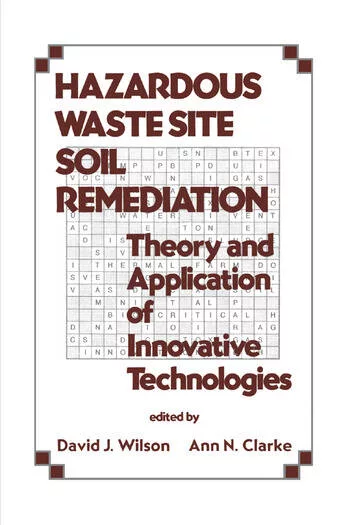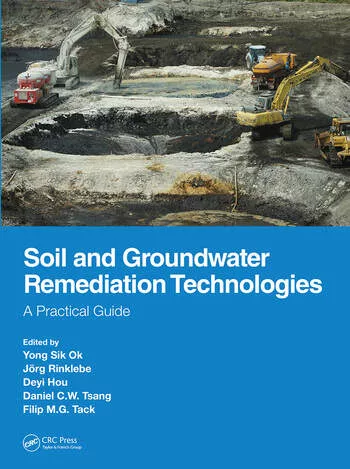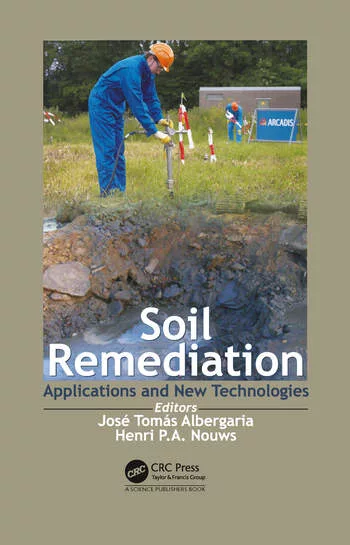Treating PFAS at the Source: A Zero-Waste, Soil Remediation Approach
Direct in-place stabilization using colloidal activated carbon offers a proven path to compliance
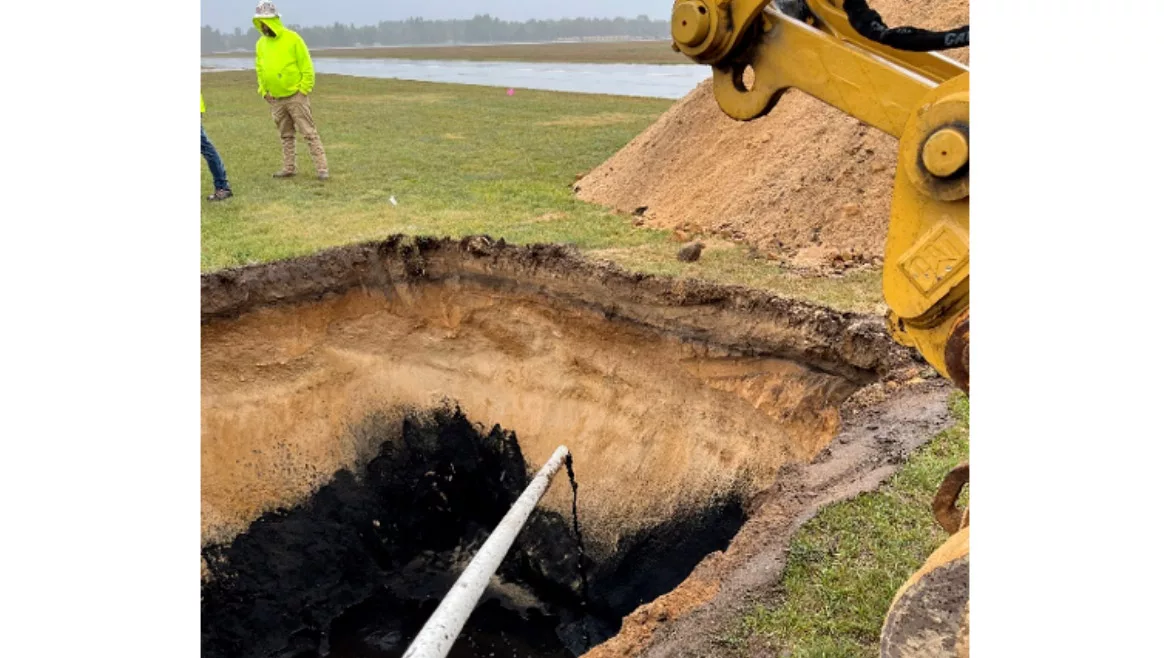
CAC is applied to the base of an excavation and mixed into soils to prevent PFAS leaching into groundwater.
As the U.S. EPA expands per- and polyfluoroalkyl substances (PFAS) designations under Comprehensive Environmental Response, Compensation, and Liability Act (CERCLA), the challenge of treating vadose-zone PFAS source areas has become central to long-term groundwater compliance. Conventional excavation and destruction technologies shift PFAS mass into secondary waste streams—creating new liabilities and high energy costs and shifting the burden to the communities near these treatment and disposal facilities. In contrast, in situ sorption and stabilization, utilizing a form of colloidal activated carbon (CAC) designed for treating contamination sources (marketed as SourceStop), immobilize PFAS directly in place, eliminating off-site transport and enabling a truly zero-waste approach to source control. Field data from North America and Europe demonstrate >99 % reductions in soil leachate within days, sustained over multiple years, marking a significant advance in PFAS soil remediation.
PFAS Source Zones and the Zero-Waste Imperative
In the United States alone, more than 57,000 sites have been flagged for PFAS impacts, with another 23,000 in Europe. Former fire-training areas, military airfields, and industrial sites where aqueous film-forming foams (AFFFs) were repeatedly used have become hotspots for vadose-zone PFAS. Once deposited, these compounds sorb strongly to organic matter and serve as long-term reservoirs that slowly leach into groundwater, exposing downstream receptors to chronic health risks.
Most soil remediation approaches aim to sever the leaching pathway and protect aquifers, yet excavation, washing, or incineration simply relocate the PFAS mass—producing PFAS-laden leachate, off-gas, or residuals governed by CERCLA and similar waste-liability regulations. In contrast, in situ sorption and stabilization target the source directly, binding PFAS in place without generating secondary waste streams.
In Situ Sorption & Soil Stabilization: Locking PFAS in Place
CAC—a patented suspension of sub-micron carbon particles (1–2 µm)—is injected or mixed into PFAS-impacted soils using direct-push or earth-moving equipment. PFAS compounds partition to the carbon via hydrophobic, and electrostatic interactions, producing partition coefficients orders of magnitude higher than the native soil. In some cases, cementitious binders such as Portland cement or lime may be added to immobilize the amendment and prevent washout. This approach stabilizes the vadose-zone reservoir in place, halting leaching with minimal disturbance to surface or subsurface infrastructure.
In Situ Sorption and Stabilization Treatment with CAC -Mechanistic Snapshot:
PFAS sorption is dominated by hydrophobic and electrostatic attraction. Increased ionic strength enhances anion binding (PFOS⁻, PFOA⁻) to positively charged sites onto CAC. Post-treatment soil leachate is verified via leaching tests or groundwater monitoring under EPA and ASTM analytical protocols.
Why In Situ Sorption Stands Alone as Zero-Waste
In situ sorption directly addresses PFAS at the source without generating new waste. It eliminates off-site transport, prevents leachate generation, reduces regulatory burden, and lowers carbon footprint.
Integrating In Situ Sorption into a Comprehensive Strategy
While in situ sorption stabilizes the vadose-zone source, complete site strategies often pair it with downstream capture to enhance PFAS retention and minimize exposure risk:
- Permeable Reactive Barriers (PRBs) – CAC-based barriers providing secondary containment of residual PFAS flux downgradient of the source.
- Post-Development Land-Use Controls – Caps and deed restrictions prevent soil disturbance during redevelopment.
In Situ Sorption and Stabilization - Key Advantages
- >99 % PFAS reduction in soil leachate within days, sustained long-term.
- Zero-waste footprint—no contaminated soil or liquid is transported off-site.
- Simple deployment—standard injection or earth-moving equipment.
- Regulatory confidence—Department of Defense studies demonstrating efficacy, performance verified through leachate testing.
Evidence from the Field
Source treatment using CAC has proven effective at multiple PFAS-impacted sites under varying soil and climatic conditions.
Camp Grayling Joint Maneuver Training Center, Michigan, USA
injection of 1–2 µm CAC beneath a former fire-training pad produced >99 % reductions in PFAS leachate within days, sustained at below targets for over 12 months.
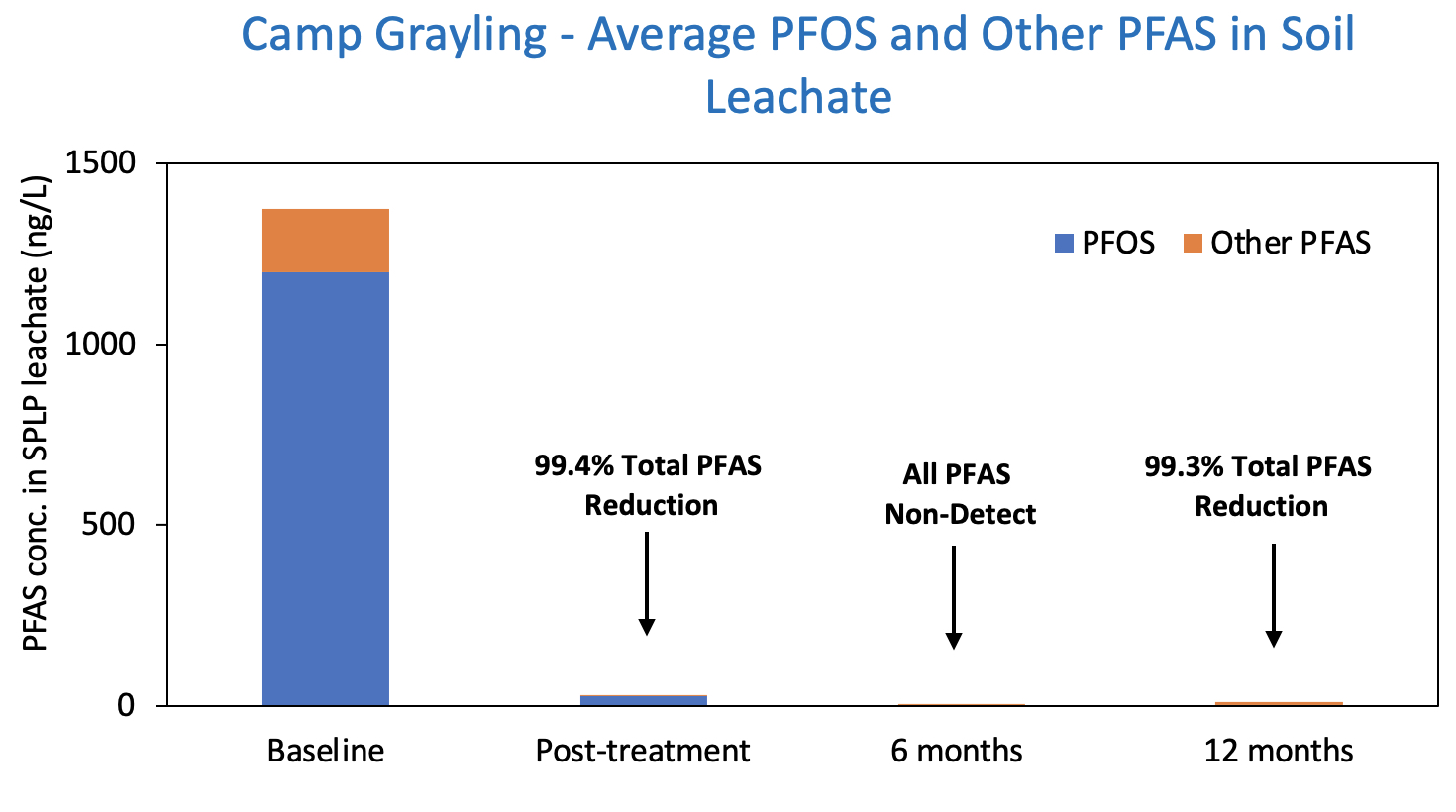
FIGURE 1: PFOS (red) and remaining PFAS concentrations (blue) in soil leachate at baseline and post-treatment following source zone treatment at Camp Grayling Joint Maneuver Training Center, Grayling, Michigan. (Courtesy of REGENESIS).
County-Owned Airport - Pacific Northwest USA
CAC was applied in situ to treat PFAS-impacted vadose-zone soils, establishing a sorptive barrier at the base of the impacted zone. Over a 24-month monitoring period, PFAS leaching from the treated soil declined by >99.7%, demonstrating the long-term stability and effectiveness of CAC as a source-control solution.
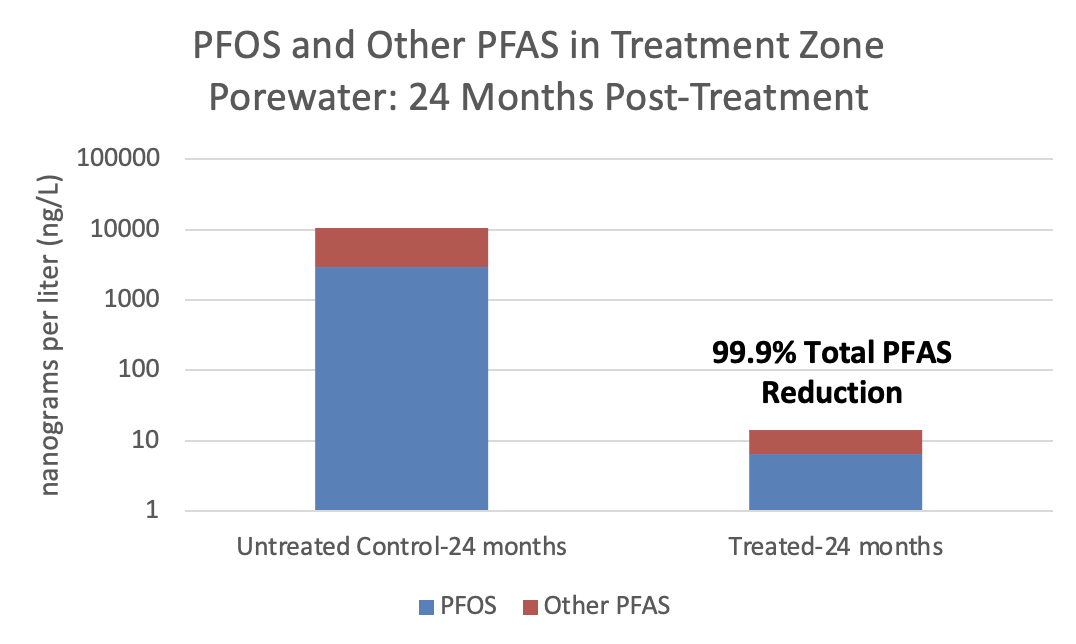
FIGURE 2: PFOS and other PFAS in porewater samples collected outside of (control) and within the treatment zone at an AFFF release area show a 99.9% PFAS reduction at 24 months. Similar reductions of 99.7% were observed in samples collected at 6 months and 12 months. (Courtesy of REGENESIS).
Textile Plant - Belgium
A subsurface CAC application reduced total PFAS in groundwater by 89 % after one month and by >99 % within five months.
Scandinavian Airport
In situ treatment using SourceStop successfully reduced dissolved-phase PFAS by >95 %, sustaining these reductions through 12 months while demonstrating full plume containment
Ongoing DoD-Funded Research on CAC Efficacy
The U.S. Department of Defense, through the Strategic Environmental Research and Development Program (SERDP) and the Environmental Security Technology Certification Program (ESTCP), is actively evaluating the use of CAC for in situ PFAS containment. Ongoing ESTCP field demonstrations and SERDP laboratory studies are exploring CAC’s sorptive capacity, amendment longevity, and field-scale delivery performance across a range of soil and hydrogeologic conditions. Collectively, these efforts continue to validate CAC as a reliable technology for controlling PFAS leaching from source zones and preventing plume migration (SERDP & ESTCP, 2023; Carey et al., 2024, Hakimabadi et al., 2023).
Ex Situ Approaches: The Waste-Stream Trade-Off
Ex situ remediation strategies for PFAS-impacted soils—including landfill disposal, high-temperature destruction, and soil washing—share a common limitation: they remove PFAS from one medium only to reintroduce it into another. While these methods can achieve high removal or destruction efficiencies under ideal conditions, they also generate residuals and long-term management obligations that challenge their sustainability.
Landfill disposal remains the most accessible pathway for excavated PFAS soils, relying on composite liners, leachate collection, and gas-control systems to isolate contaminants. However, even modern engineered landfills exhibit evidence of PFAS leakage. U.S. surveys have detected PFAS in groundwater near nearly all studied sites, including 98% of closed landfills in Minnesota and 77% of inactive landfills in New York state. In the UK, monitoring across 14 lined facilities found PFOS concentrations increased at 11 sites, indicating that standard leachate-treatment processes may not effectively remove—and can even concentrate—certain PFAS compounds (Neill and Megsen, 2024). These results underscore the persistence of PFAS and the limitations of conventional containment as a permanent solution.
". . . new information demonstrates landfilling could have higher PFAS releases to the environment than previously thought in 2020 (USEPA, 2024)."
Thermal destruction via hazardous-waste incinerators and cement kilns can achieve >99.9% destruction under optimized conditions. The alkaline matrix of cement kilns helps fix fluorine as calcium fluoride (CaF₂), reducing gaseous emissions. However, destruction efficiencies are highly temperature-dependent—with certain PFAS requiring sustained operation above 1,400 °C—and incomplete combustion can generate fluorinated by-products. Limited full-scale data and evolving regulatory scrutiny have constrained the expansion of this approach.
“The stability of perfluorinated radicals and their propensity to recombine present the potential for the creation of PFAS PICs distinctive from the original fluorinated compound. (USEPA, 2024)."
Soil washing physically separates coarse and fine soil fractions through hydraulic and mechanical processes, removing up to 90–98% of PFOS/PFOA from coarse materials in pilot studies. However, fine sediments (<63 µm) and PFAS-laden wash water require secondary treatment with granular activated carbon or ion exchange. High water and power demands, coupled with limited suitability for silty soils, restrict soil washing to large-scale projects where space and infrastructure are available.
Collectively, these ex situ methods illustrate a key paradox: while they may remove PFAS from the treatment site, they perpetuate the waste-stream problem through residual liquids, solids, and off-gas that must be captured, treated, or disposed of elsewhere.
|
Method |
Mechanism |
Benefits/Efficiency |
Primary Liabilities |
|
Landfill Disposal |
Excavation + isolation in lined landfill |
PFAS removed from the site; >98 % containment in landfill (liquid phase) |
Future leachate generation; liner degradation; CERCLA liability |
|
Incineration / Cement Kilns |
Thermal cleavage ≥1,400 °C; CaO fixation of fluorine |
>99.9 % destruction under optimal conditions |
High cost and energy; limited capacity; incomplete combustion risk |
|
Soil Washing |
Hydraulic/surfactant washing; mechanical fractionation |
90–98 % PFOS/PFOA (coarse fraction) |
Wash-water residuals; high water/power demand; limited for silt/clay >25 % |
Table 1. Summary of ex-situ PFAS removal/destruction methods, including mechanisms, benefits/removal efficiency, and liabilities.
Collectively, these ex situ methods illustrate a key paradox: while they may remove PFAS from the treatment site, they perpetuate the waste-stream problem through residual liquids, solids, and off-gas that must be captured, treated, or disposed of elsewhere—often in communities already facing disproportionate environmental burdens and elevated exposure risks near landfills, incinerators, and waste-treatment facilities.
Conclusion
PFAS soil treatment technologies fall into two clear paradigms: in situ immobilization—which stabilizes PFAS mass in place without creating waste streams—and ex situ destruction/removal—which shifts PFAS into new residuals, ash, or concentrates. For source-area remediation, in situ sorption and stabilization stand alone as the only zero-waste option. Backed by reproducible field data, rapid performance, and regulatory familiarity, this approach offers consultants and site owners a sustainable pathway to break the PFAS cycle—without creating a new one.
References
Carey G.R., R.H. Anderson, P.V. Geel, R. McGregor, K. Soderberg, A. Danko, S.G. Hakimabadi, A.L. Pham, and M. Rebeiro-Tunstall. 2024. Analysis of Colloidal Activated Carbon Alternatives for In Situ Remediation of a Large PFAS Plume and Source Area. Remediation Journal, 34(1):e21772. doi.org/10.1002/rem.21772.
Hakimabadi S.G., A. Taylor, and A.L. Pham. 2023. Factors Affecting the Adsorption of Per- and Polyfluoroalkyl Substances (PFAS) by Colloidal Activated Carbon. Water Research, 242: 120212. doi.org/10.1016/j.watres.2023.120212.
Minnesota Pollution Control Agency. (2024). PFAS and closed landfills. Retrieved from https://www.pca.state.mn.us/land/maintaining-closed-landfills-in-minnesota.
Neill P and Megson D (2024) Landfill leachate treatment process is transforming and releasing banned per- and polyfluoroalkyl substances to UK water. Front. Water. 6:1480241. doi: 10.3389/frwa.2024.1480241
SERDP & ESTCP. (2023). Validation of colloidal activated carbon for preventing the migration of PFAS (ER21-5183). U.S. Department of Defense. https://serdp-estcp.mil/projects/details/7f88fd23-2aff-4e32-a01b-5e2c959d8c8c
SERDP & ESTCP. (2023). An investigation of factors affecting in situ PFAS immobilization (ER21-5159). U.S. Department of Defense. https://serdp-estcp.mil/projects/details/84e79055-861f-46dd-abbc-4b526c54d798
U.S. Environmental Protection Agency. (2024). Interim guidance on the destruction and disposal of per- and polyfluoroalkyl substances and materials containing PFAS (updated 2024). U.S. Environmental Protection Agency. https://www.epa.gov/system/files/documents/2024-04/pfas-destruction-disposal-interim-guidance.pdf

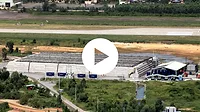

.webp?height=200&t=1720617286&width=200)
